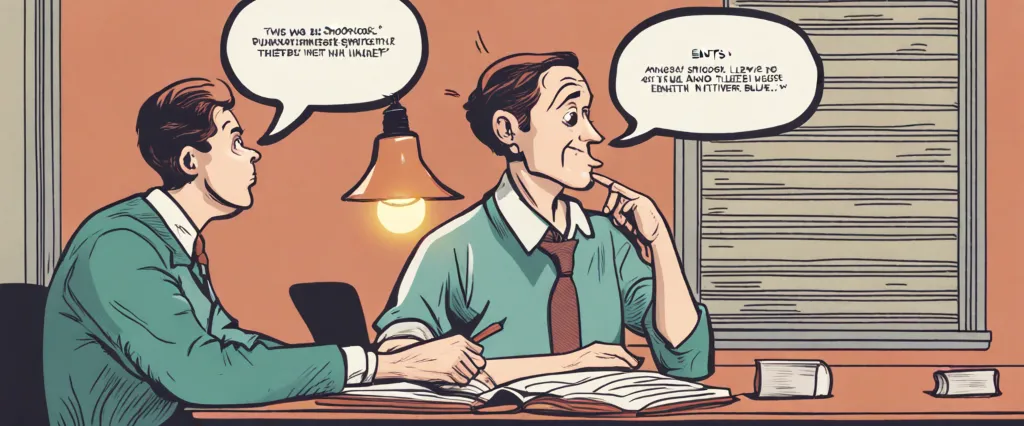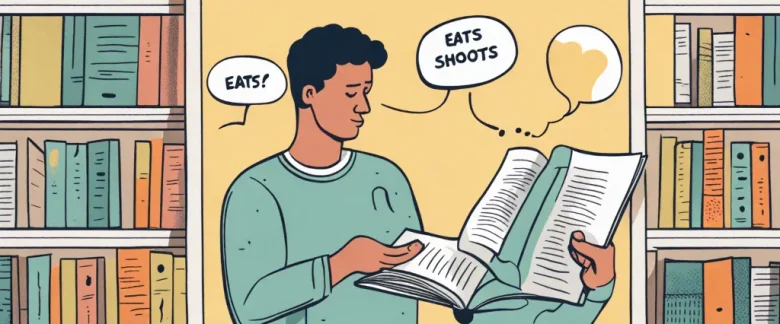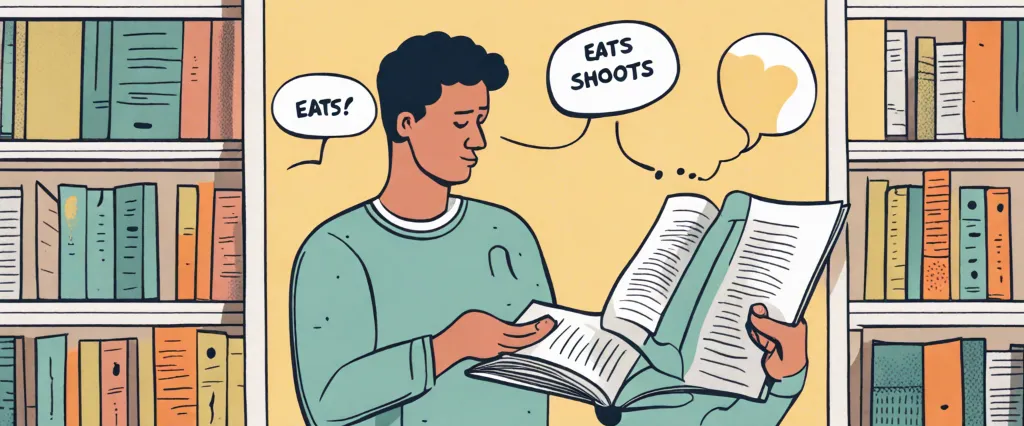In “Eats, Shoots & Leaves,” Lynne Truss presents a delightful and humorous exploration of grammar and punctuation. With a keen eye for the often-overlooked subtleties of language, she playfully demonstrates how punctuation marks shape our understanding and communication. Lynne Truss is a British author and journalist known for her love of language. In addition to writing numerous books on grammar and writing, she has also contributed to various newspapers and magazines, showcasing her wit and expertise in the realm of punctuation. Through her engaging style, Truss captivates readers, encouraging them to take a closer look at the power of punctuation in our everyday lives.
Chapter 1: The Importance of Punctuation: Exploring the Role and Impact of Correct Punctuation in Written Communication
Chapter 1 of “Eats, Shoots & Leaves” by Lynne Truss, titled “The Importance of Punctuation: Exploring the Role and Impact of Correct Punctuation in Written Communication,” emphasizes the crucial role that punctuation plays in conveying clear and precise meaning in written language.
Truss begins by highlighting the severe consequences that can arise from the misuse or absence of punctuation in written communication. She humorously illustrates the ambiguity caused by misplaced commas, apostrophes, and other punctuations through comical anecdotes and examples. These examples demonstrate how punctuation can drastically alter the intended meaning of a text, leading to confusion, misinterpretation, or even ridicule.
The chapter further emphasizes the historical evolution and development of punctuation. Truss examines the origins of punctuation, its gradual acceptance as a vital aspect of language, and its role in shaping the clarity and meaning of texts. She asserts that punctuation is not an arbitrary set of rules but a system designed to aid readers in comprehending texts accurately.
Truss also discusses the rise of a more relaxed and lenient attitude toward punctuation in modern times, partly due to the influence of technology and the internet. She argues that while some claim that punctuation is unnecessary in informal digital communication, such as emails or text messages, punctuation remains vital for effective and precise written communication.
Ultimately, Chapter 1 of “Eats, Shoots & Leaves” establishes the significance of proper punctuation for conveying intended meaning and avoiding confusion. Truss asserts that punctuation is more than a tool for grammar nerds, but an essential element for clear, effective, and enjoyable communication.
Chapter 2: Commas: Mastering the Art of Using Commas Effectively and Avoiding Common Mistakes
Chapter 2 of the book “Eats, Shoots & Leaves” by Lynne Truss focuses on the proper usage of commas. Truss emphasizes the importance of mastering the art of using commas effectively and avoiding common mistakes.
The chapter begins by discussing the widespread misuse and abuse of commas in contemporary writing. Truss states that knowing the rules of comma usage is essential for clear and effective communication, as commas are used to provide clarity, avoid ambiguity, and indicate pauses in speech.
Truss presents various situations where commas are frequently misused or overlooked. She highlights the importance of punctuation in preserving meaning and humor in sentences. For instance, the famous example “Eats shoots and leaves” and “Eats, shoots, and leaves” showcases the need for a comma to differentiate between two possible meanings.
The chapter explores different categories of comma usage, including parenthetic commas used for nonessential information, commas in lists, and the comma splice. Truss provides examples and explanations to help readers understand when and how to correctly apply commas in these situations.
Additionally, Truss addresses common comma mistakes, such as the confusion between restrictive and nonrestrictive clauses. She presents rules and guidelines to assist readers in distinguishing between the two and properly punctuating sentences accordingly.
Overall, the chapter emphasizes the significance of using commas with precision and care to convey meaning accurately. Truss passionately argues that mastering the art of using commas effectively is crucial for writers, as their misuse can alter meaning, cause confusion, and even deteriorate the quality of written communication.
Chapter 3: Apostrophes: Understanding the Correct Usage of Apostrophes to Indicate Possession and Contractions
Chapter 3 of “Eats, Shoots & Leaves” by Lynne Truss explores the correct usage of apostrophes in indicating possession and contractions. Truss focuses on clarifying common misconceptions and providing readers with practical rules to follow.
The chapter starts by acknowledging the apostrophe’s dual purposes: to indicate possession and to form contractions. Truss emphasizes that it is essential to grasp these functions in order to fully understand and utilize apostrophes correctly.
She delves into the confusion surrounding possessive pronouns, such as its and theirs, which do not require the use of an apostrophe. Truss points out that apostrophes are only needed in possessive pronouns when there is an element of contraction involved, for example, “one’s” or “let’s.”
The author provides various examples and anecdotes that highlight the potential ambiguity and humorous misunderstandings that can result from incorrect apostrophe usage. She offers clear guidelines on forming possessive forms, emphasizing the distinction between singular and plural nouns.
Furthermore, Truss examines the “its vs. it’s” predicament, explaining that “its” is the possessive form, while “it’s” is a contraction of “it is” or “it has.” She emphasizes the importance of proofreading for apostrophe usage in order to maintain clarity and professionalism.
To further clarify, Truss addresses the issue of using apostrophes with plural nouns. She emphasizes that apostrophes should never be used to indicate plural forms, only possessive forms. For instance, “The Smiths’ house” signifies that the house belongs to the Smith family.
In summary, Chapter 3 of “Eats, Shoots & Leaves” provides a comprehensive guide on the appropriate use of apostrophes in indicating possession and forming contractions. Truss uses engaging examples and anecdotes to drive home the importance of accuracy and clarity when using apostrophes. By following her guidelines, readers can effectively employ these punctuation marks to convey meaning accurately.
Chapter 4: Dashes, Hyphens, and Ellipses: Navigating the Proper Use of these Punctuation Marks for Clarity and Emphasis

Chapter 4 of “Eats, Shoots & Leaves” by Lynne Truss is titled “Dashes, Hyphens, and Ellipses: Navigating the Proper Use of these Punctuation Marks for Clarity and Emphasis.” In this chapter, Truss explores the correct usage and nuances of dashes, hyphens, and ellipses, emphasizing the importance of understanding their purpose and using them appropriately in writing.
She begins by discussing dashes, explaining the differences between the shorter en dash (–) and the longer em dash (—). The en dash is primarily used to indicate a range, whereas the em dash is employed for emphasis, interruption, or as a substitute for other punctuation. Truss provides numerous examples to illustrate the correct usage of dashes and advises against confusion with hyphens or double hyphens.
Moving on to hyphens, Truss clarifies their role in joining words or parts of words to form compound words, and the importance of consistency in their application. She highlights that proper hyphenation can affect the meaning and clarity of a sentence, while incorrect usage can lead to ambiguity or unintended implications.
Finally, the chapter covers ellipses, which are used to indicate a trailing off, an omission, or the passing of time. Truss discusses the appropriate situations for using ellipses and warns against their overuse, as they can disrupt the flow of writing and reduce clarity.
Throughout the chapter, Truss provides clear explanations, engaging anecdotes, and relatable examples to facilitate understanding and ensure that writers can correctly incorporate dashes, hyphens, and ellipses into their writing to enhance clarity and emphasize their intended meaning.
Chapter 5: Colons and Semicolons: Grasping the Functions and Correct Placement of Colons and Semicolons in Sentences
Chapter 5 of “Eats, Shoots & Leaves” by Lynne Truss delves into the functions and correct placement of colons and semicolons in sentences. Truss humorously explores the often misunderstood and misused punctuation marks, offering guidance on using them correctly to enhance clarity and coherence in writing.
The chapter starts by differentiating between colons and semicolons. A colon is primarily used to introduce a list, an explanation, or a summary, whereas a semicolon indicates a stronger connection between two independent clauses that can stand alone as separate sentences. Truss emphasizes that using these punctuation marks correctly is essential to avoid confusion and maintain the integrity of one’s writing.
Truss provides numerous examples and explanations of how to use colons effectively. For instance, she demonstrates how we can use colons to introduce quotations, examples, or elaborations that amplify the previous statement. Additionally, she highlights the importance of correctly using a colon after a complete sentence to introduce a speech, a bulleted list, or a formal message.
Moving on to semicolons, Truss explains how they can be used to join independent clauses that are closely related, creating a stronger link than a simple comma. She emphasizes that semicolons should only be used when the two independent clauses are closely related in content and share a common theme or purpose. Truss cautions against overusing semicolons and advises writers to reserve them for specific occasions where the connection between clauses is profound.
Throughout the chapter, Truss skillfully combines explanations, anecdotes, and examples to highlight the correct functions and placements of colons and semicolons. By providing clarity on their usage, she inspires readers to embrace these punctuation marks and utilize them effectively.
Chapter 6: Quotation Marks: Learning the Rules for Quoting Direct Speech and Indirect Quotations
In Chapter 6 of “Eats, Shoots & Leaves” by Lynne Truss, the focus is on quotation marks and the rules for using them correctly. Truss emphasizes the importance of using quotation marks when quoting direct speech or presenting indirect quotations.
The chapter begins with a discussion on the different styles of quotation marks, such as single quotation marks used in British English and double quotation marks used in American English. Truss emphasizes that consistency is key and advises writers to choose one style and stick to it throughout their writing.
Truss introduces the concept of direct speech, which is the verbatim quoting of someone’s words. She explains that direct speech should always be enclosed within quotation marks. However, punctuation rules can vary depending on whether the quoted speech is a complete sentence or not. Truss provides clear examples and explanations of how to handle different scenarios involving commas, full stops, and other punctuation marks.
The chapter then moves on to indirect quotations, which are paraphrases or summaries of someone’s words. Truss astutely notes that indirect quotations do not require quotation marks, as they are the writer’s interpretation or reporting of what was said, rather than the actual wording.
Truss also addresses other aspects related to quotation marks, such as the positioning of punctuation marks in relation to the quotation marks. She highlights the general rule of placing most punctuation marks inside the closing quotation mark, with only a few exceptions.
Overall, chapter 6 of “Eats, Shoots & Leaves” provides a comprehensive understanding of the rules and nuances associated with using quotation marks correctly, ensuring that writers can accurately present direct speech and indirect quotations in their writing.
Chapter 7: Capitalization and Italics: Examining the Guidelines for Capitalizing Words and Using Italics for Emphasis and Titles
Chapter 7 of “Eats, Shoots & Leaves” written by Lynne Truss focuses on the rules and guidelines for capitalization and the use of italics. Truss emphasizes the importance of proper capitalization and its impact on the meaning and clarity of sentences and titles.
Truss begins by discussing the different categories of words that are typically capitalized. Proper nouns (names of individuals, places, and companies) are always capitalized. Common nouns, on the other hand, are only capitalized if they are part of a title or at the beginning of a sentence.
The chapter also addresses the confusion surrounding capitalization in titles. Truss provides several examples where people mistakenly capitalize every word, rather than only capitalizing important words such as nouns, adjectives, and verbs. She stresses that unnecessary capitalization not only leads to confusion but also breaks basic grammatical rules.
Furthermore, Truss delves into the use of italics for emphasis. She explains that it is essential to use italics sparingly and purposefully to highlight words or phrases that need extra emphasis. Too much use of italics can make writing come across as unprofessional or overly dramatic.
The author also focuses on the correct usage of italics when it comes to titles of books, movies, artwork, and other creative works. Truss provides specific guidelines for italicizing titles, including the use of quotation marks for titles of shorter works within larger works.
Overall, Chapter 7 of “Eats, Shoots & Leaves” serves as a comprehensive guide for understanding the correct capitalization rules and using italics effectively. It provides readers with practical advice on how to make their writing clearer, more professional, and grammatically correct.

Chapter 8: Common Grammar Mistakes: Addressing Common Errors in Grammar and Providing Tips for Improvement
In Chapter 8 of “Eats, Shoots & Leaves,” Lynne Truss delves into common grammar mistakes and offers tips for addressing these errors. Truss begins by discussing the confusion between the use of “less” and “fewer.” She explains that “less” is appropriate when referring to quantities or uncountable items, while “fewer” should be used with countable objects or items. She emphasizes that maintaining this distinction is crucial for clarity and correctness in writing.
The chapter then proceeds to tackle the incorrect use of the apostrophe. Truss points out that apostrophes are often misused or added unnecessarily in plural nouns, such as in phrases like “banana’s” or “CD’s.” She urges readers to pay attention to possessives, reminding them that apostrophes are only used to indicate possession or contraction, not for pluralization.
Another common mistake addressed in this chapter involves the misuse of pronouns and their antecedents. Truss explains the importance of ensuring that pronouns agree in number and gender with the nouns they refer to. She highlights common errors such as using “they” instead of “he or she” in situations where the gender is indefinite. Truss provides tips on how to rewrite sentences to maintain clarity and avoid ambiguity.
Furthermore, the chapter touches on the misuse of homophones. Truss highlights examples like “its” versus “it’s,” “they’re” versus “their,” and “accept” versus “except.” She stresses the importance of double-checking these commonly confused words to prevent errors that can alter the meaning of a sentence.
Overall, Chapter 8 of “Eats, Shoots & Leaves” aims to help readers recognize and correct common grammar mistakes through clear explanations and practical advice. By addressing these errors, Truss encourages writers to enhance their grammar skills and improve the overall clarity and effectiveness of their writing.
After Reading
In conclusion, “Eats, Shoots & Leaves” by Lynne Truss is a witty and informative guide on the importance of punctuation. Truss enlightens readers about the evolution of punctuation and provides numerous examples of its misuse. She emphasizes the significance of proper punctuation in maintaining clarity and avoiding misinterpretations. Through her humor and insightful anecdotes, Truss encourages readers to appreciate and adhere to the rules of punctuation. “Eats, Shoots & Leaves” serves as a valuable resource for anyone interested in mastering the art of punctuation and enhancing their writing abilities.
1. “The Elements of Style” by William Strunk Jr. and E.B. White – This book offers clear, concise, and practical advice on English language usage. It covers grammar, punctuation, and style, making it an indispensable guide for anyone who wants to improve their writing skills.
2. On Writing Well” by William Zinsser – This book provides valuable insights and techniques for crafting clear and engaging prose. It focuses on nonfiction writing, helping readers to communicate effectively and find their unique writing voice.
3. The Sense of Style: The Thinking Person’s Guide to Writing in the 21st Century” by Steven Pinker – Pinker delves into the rules and beauty of language, debunking common grammar myths and offering fresh perspectives on writing. With a blend of wit and wisdom, this book encourages readers to embrace simplicity and clarity in their writing.
4. “Dreyer’s English: An Utterly Correct Guide to Clarity and Style” by Benjamin Dreyer – In a similar vein to “Eats, Shoots & Leaves,” Dreyer’s English explores common writing errors, punctuation dilemmas, and language eccentricities with a touch of humor. It’s an engaging and practical guide for writers and editors.
5. “The Chicago Manual of Style” – A revered reference book used by countless writers, this comprehensive manual covers all aspects of writing, editing, and publishing. It provides guidance on grammar, punctuation, citations, and much more, making it an invaluable resource for any serious writer or editor.
These recommended books share the common thread of offering guidance on grammar, punctuation, and writing style. They provide practical strategies, examples, and insights that can help both aspiring and experienced writers sharpen their language skills and improve their written work.




